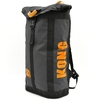The Valley of the Moon: climbing in Jordan's Wadi Rum

 1 / 71
1 / 71 archivio Manrico Dell'Agnola Marcello Sanguineti
archivio Manrico Dell'Agnola Marcello Sanguineti
Knowing all about the endless border checks when crossing from Israel into Jordan, this time I chose to not to fly to Eilat (in Israel's far south) and enter Jordan through Rabin's Pass but instead I decided to fly directly to Amman. Wadi Rum is reached from here via a 4-hour jeep ride, instead of the hour and a quarter that needed to reach this Bedouin village from the Israeli – Jordanian border, but little time is wasted as all you need is a simple tourist visa, which is easily got at the airport.
Imperturbable Mohamed, a pleasant Bedouin picked us up from the Amman airport and drove us overnight to Wadi Rum. Numerous pit stops to drink tea enabled him to stay awake, and he told us he didn't drink coffee as this did him no good. Having said that, he smoked one cigarette after the next and this, combined with the open car window, immediately gave Manrico a sore throat that would stay with him throughout his trip. In the days that followed Manrico constantly complained that “it's just unbelievable, a sore throat in the desert because of that Bedouin!”
At Wadi Rum we were the guests at Alì and his wife Aliya, a family with only four children (for the moment): an anomaly, as the average for families at Wadi Rum is eight to nine babies, with a record being set by some audacious father at 27, though it has to be said he achieved this with three wives. Our accommodation was spartan but nevertheless comfortable enough: we lived in a building annexed to Alì's house, with an entrance, basic toilet and “bedroom” with two mattresses placed on the floor.
There was even the shower with hot water, even if the amount of water that came out caused us to question whether the term "shower" was appropriate. As soon as we were settled in our suite we assessed our situation. Due to work commitments I only had five days of climbing: I'd have to depart at nine in the evening on day 5 and drive back to Amman, from where an overnight flight would take me back to Genoa via Istanbul. And so, despite being somewhat tired from our travels, we decided to commence place the next morning.
We woke up and had breakfast under the pergola: pita (flat, round leavened bread made from wheat flour), honey, jam, yogurt, coffee and tea. Still drowsy we set off from Ali's house towards the NE Domes of Jebel Rum, where we climbed King Hussein, a tasty appetizer for what lay in store during the next few days. The comments regarding this climb were peculiar and ranged from "one of our best routes in Wadi Rum" according to the Remy brothers who'd made the first ascent to "a wonderful route, but with poor rock quality on the higher pitches" to "a terrifying outing up vertical sand"... As is often the case, the truth lies somewhere in between: some pitches up great rock give way to others that require care and attention. On the whole though this is a marvelous route up the gigantic chimney that splits the East Face of the NE Domes of Jebel Rum. We had difficulty orientating ourselves during the return, something we hadn't had at the start of the day: all the houses in the village looked the same and we struggled to find Ali's!
The next morning we drove by jeep to the Barrah Canyon: a gob-smacking corner of the desert where last year I'd climbed The Star of Abu Judaidah together with Gian Luca Cavalli and Marco Scagnetto. We hadn't climbed legendary Merlin's Wand up the North tower tof Abu Judaidah and this second visit to Wadi Rum gave me the chance to give it a go! Known as the "Supercrack of Wadi Rum”, from a distance it looks similar to Supercrack of the Desert in Utah and while the difficulties are similar, the Wadi Rum version is much, much longer. The pitches through the cracks are elegant and technically pleasing, though never too difficult and the route is set in such beautiful surroundings that we forget everything as we climb and get lost in the incredible rock features, the canyon's infinite array of colours, the caravan routes impressed in the sand and countless rock formations on the horizon. As we descended we noticed a large group of Bedouins at the base of the peak and from our last abseil we heard them heatedly discuss our rope maneuvers. We touched the ground to a round of thunderous applause. What better opportunity to take some photos with the locals? We explained how we use the gear and those strange objects, Friends, attracted their attention more than anything else. We then let Khalid - one of the many children there – experience the thrill of top-roping half a pitch and his climbed risked being stopped short by the shouts of the concerned mothers who suddenly appeared from behind the thick bushes, behind which they'd been relegated by their husbands. Their loud protests were quickly silenced by men who somewhat unceremoniously ordered them back which the women did instantly, without protest whatsoever. When Ali arrived with the jeep to take us back to the village he first asked us whether we wanted to see the camp that he and his brother have established in the desert to accommodate tourists: advertising is the soul of commerce... In short, he showed us around the “family belongings” with the aim of getting some new customers... At his Sunrise Camp, set amazingly at the foot of the Khazali, the ineffable Jamaal smoked a shisha (an instrument that contained scented water with a spiral that enables the smoke to cool cool down before being inhaled). He invited me to try it, assuring me that the tobacco leaves were impregnated by a sort of molasses, but he failed to convince me: his eyes, lost in Wadi's infinite desert, told me a somewhat different story...
On day three it was time for the Abu Aina Towers. For breakfast I asked Aliya to prepare hummus (made of chickpeas and sesame seeds, flavored with olive oil and cumin) and tahini (toasted and crushed sesame seed flour, diluted with sesame oil). I love these dishes and I told Manrico they're a delicacy, but my partner didn't like them at all and handed me his portion. "So much the better!" - I thought to myself, devouring the contents of the bowl with pleasure. Ali then gave us a ride to the base of the Abu Aina Towers and dropped us off in the middle of a surreal landscape : we are next to a gigantic and very green tree born " in the middle of nothing ", at the foot of weathered outcrops, walls hundreds of metres high, separated from the desert by huge detrital pedestals. After an hour's approach we reached a sort of suspended valley, invisible from below, from where a hidden ledge led to the start of our chosen route: Lionheart. The first ascentionists, Roland and Mark Edwards, had described it "one of the best new routes we have ever done, with superb crack and groove climbing." And we couldn't blame them: the route climbed a system of corners, chimneys and cracks that run down the otherwise unclimbable face and features powerful and then technical pitches with an unexpected slab finish. The only drawback: the start of the chimney of pitch three with its questionable quality rock. But the rest of the route more than compensated for this detail! Our return at sunset offered breathtaking views that made us stop and contemplate, hence our slow descent. This time Ali didn't pick us up by jeep and so we walked down the track from Abu Aina Towers to the village where, due to the darkness, we wandered around for a while in search of Ali's house. As soon as we arrived we voraciousl “dug in” to our "proud meal": rice, chicken, banana, the usual tea and coffee. Then we rushed off to bed, to recover as much as possible for our next objective the following day.
Day four began with another long jeep drive. This time we head of SW, towards Al Maghrar. Its NE face hides a true desert gem: Desert Rats in the Shade, a corner that cuts down the entire face. Ali dropped us off about forty minutes from the start. The approach led us through a small canyon, that ended in a valley at the base of the face. All around us were scattered boulders of all shapes and sizes, a geologist's delight. The route offered cracks of all sizes in the back of the enormous corner that led to a sort of rocky terrace, suspended high above the desert and topped by a series of seemingly insurmountable slabs.
The next day we ended play on Hammad 's Domes at Jebel Rum. We chose to climb Le Grec, the route climbed Remy brothers and dedicated to Georges Livanos up the pillar of the same name. Despite Pillar Livanos being relatively close to the village, it is located in a secluded amphitheater that gives you a feeling of total isolation. The line is truly beautiful: three pitches up a crack in the back of a corner that finishes all of a sudden right in the middle of the immense south face of the pillar to the left of the Pillar of Wisdom. At this point, just when it seems as if you're in a dead-end, a ledge appears on the right that leads past the large roof and on to a series of chimneys and overhanging cracks to the top of the tower. On the penultimate pitch I, very naively, dropped my descender. I often take a spare one with me, but this time no. While I cuss I resign to the fact that this is another one of those examples of “the principle of how bad luck preserves itself.” Never mind, the numerous abseils would be a good opportunity to brush up on how to use carabiners to abseil. During the rappels along came another example of what I mentioned above: seeing that I was in a rush to get back to the village, as Mohammed had to take me back to the airport, one of the abseils got stuck. To cut a long story short: we reached the village later than planned, in last light and, for the third time, we wandered around aimlessly in search of Ali's house. At this point all the Bedouins at Wadi Rum must have got used to that pair of climbers who kept wandering around, lost, past their houses...
I had just enough time to gulp down some rice, pita and hummus. In between mouthfuls, Manrico and I looked back at five intense days of climbing: not many, but nevertheless more than enough to come away with a rich booty of routes climbed in this vertical sandstone temple, all strictly trad. I said goodbye to Aliya, her four children and Ali, who hugged me and said the classic "Inshallah" I then jumped onto the jeep and Mohamed crossed the 300 kilometers back to Amman in record time. I checked-in, raced to the gate and arrived home in the middle of the night, ready for a business meeting a few hours later. Manrico on the other hand stayed on in Jordan for another ten days to enjoy the second part of his holiday, as a true tourist, relaxing...
Thanks
Marcello Sanguineti (CAAI)
Karpos/Sportful, clothing for free time and the outdoors.
Climbing Technology, climbing equipment.
Dolomite, shoes for alpinism, trekking and the outdoors.
Geoborders Italy: sale, rent and assistance of satellite equipment



 Copia link
Copia link



















 See all photos
See all photos






















